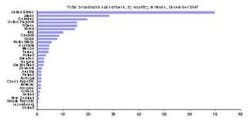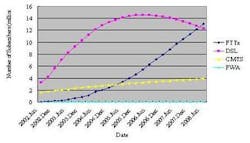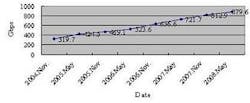More glass than copper: Japan's broadband optical access market
Led by a variety of carriers and spurred by government policies, Japan has emerged as the world's leader in FTTH deployment. The market has spurred new equipment requirements.
By Hirokazu Ozaki
NEC Corp.
Japan is the first broadband access market in which the number of optical access subscribers exceeds the number of DSL subscribers. In this paper, we will review the current status of the Japanese broadband market, examine the implications for the network, and consider the requirements of FTTx network devices.
Market overview
Japan currently ranks second to the United States in the total number of broadband subscribers as shown in Figure 1. These subscribers are predominantly served using the following access technologies:
- exchange-based ADSL
- Active Ethernet point-to-point (P2P) FTTH
- P2P fiber to the building (FTTB) with VDSL tails to the subscriber
- PON-based FTTH
- PON-based FTTB with VDSL tails.
Click here to enlarge image
Figure 1. Number of broadband subscribers by country [Source: OECD statistics, www.oecd.org].
Japan's incumbent carriers, NTT East and NTT West, first introduced ADSL over a decade ago, initially with rates of up to 1.5 Mbps. Market deregulation enabled the introduction of new broadband access carriers, including eAccess and ACCA. Over time, the broadband market saw dramatic price reductions, improved service reliability, and increased service rates to 40 Mbps via quad-band ADSL.
DSL service take-up peaked in 2006 with the increased availability of higher-rate FTTB- and FTTN-based services. Now, nearly three years later, the number of FTTB/FTTH subscribers has exceeded 13 million and has surpassed DSL as shown in Figure 2. NTT East's and NTT West's share of FTTx subscribers exceeded 70% during the third quarter of 2007 [1]. It is now expected that FTTB/FTTH deployments will continue to grow until access is provided to most of Japan's 45 million households, according to research by IDC Japan.
Click here to enlarge image
Figure 2. Number of broadband access subscribers in Japan [Source: Ministry of Internal affairs and Communications in Japan, www.soumu.go.jp/]
In densely populated Japanese urban areas, IEEE 802.3ah GE-PON (also known as EPON) is the most popular optical access technology and is deployed mainly by NTT East, NTT West, and KDDI. The dominant deployment type is FTTB; GE-PON is terminated either on the outside of the building wall or in the building's equipment room, with 100-Mbps symmetric VDSL used for connection to each subscriber.
The drivers for deploying FTTB/FTTH are advanced multimedia services, including IPTV, HDTV, VoD, VoIP, VPNs, etc. Main operators such as NTT East, NTT West, KDDI, and Softbank provide an extensive service menu to customers and leverage their broadband connections to increase their subscribers and revenues.
The Japanese government also supports the deployment of FTTB/H. The Ministry of Internal Affairs and Communications has the "u-Japan Policy" to realize a ubiquitously networked society in which anyone can easily access and use a network anytime from anywhere in order for Japan to achieve the status of "the world's leading nation for ubiquitous network society" by 2010. In the policy, the government declared that broadband services should be available in all areas of Japan. The policy promotes the deployment of broadband access, i.e., FTTB/H. The government reduces regulations while at the same time ensures fair and legitimate business operations for telecommunication service providers by revising the law to safeguard subscribers. [2].
FTTx service-delivery architectures may be categorized into three types:
- active point-to-point (P2P)
- passive mesh (PON)
- VDSL-based systems targeting multi-dwelling units (MDUs).
Japan's leading carriers are now planning for the deployment of next generation PON systems to continue to provide the bandwidth required by new advanced multimedia services in the future.
Implications for the network
There are several implications for the network that arise from the widespread use of FTTB / FTTH.
With greater access speed comes the demand for capacity expansion in the edge and the core. Carriers have relied upon WDM technology for both the edge and the core networks. CWDM has been deployed in the edge, and recently ROADM-based DWDM has also found its way from the core of the network to the edge. ROADM and WDM are both widely deployed as active optical technologies, as opposed to the passive optical splitters used in the PON access network. WDM technology may eventually find its way into the access network as the leading standards body for PON, the Full Service Access Network, is considering both WDM PON and 10G PON as potential candidates for next-generation PON standards.
Figure 3 shows the transition of Internet traffic in Japan. The rapid growth of Internet traffic signals the application of WDM technology in access networks in the future.
Click here to enlarge imageFigure 3. Transition of the Internet Traffic in Japan [Source: Ministry of Internal Affairs and Communications, Japan, "Information and Communications in Japan," 2007]
Broadband equipment requirements
The key features required by FTTH/FTTB network node devices that are located in central offices include the following.
- high density (see Figure 4 as an example)
- large-capacity switch fabric
- high-bit-rate interface cards
- low capex (e.g., based on ATCA standards for multi-source components and standard design) and
- low opex (e.g., low power consumption)
- rich provisioning, fault location, and performance monitoring functions
- fault tolerance capabilities such as redundancy.
Figure 4. Ultra-high density, highly flexible, extreme throughput platforms for aggregation of remote devices, GPON OLT, and high-density DSL or POTS are necessary for FTTH/B nodes. [Source: NEC]
Although the above items are not limited to Japan, high density is especially important for densely populated Japanese urban areas.
Low power consumption is an increasingly important requirement for reducing growing operator power costs. Regulatory initiatives to promote the reduction of power consumption are likely in an effort to mitigate environmental concerns.
Summary
We reviewed the current status of FTTx in Japan and analyzed what is required for FTTx network devices now and in the future. We also examined current activities and future plans for the development of FTTx (PON) systems. As the leader in broadband penetration, Japan offers the global telecommunications industry insight into deployment trends and how they will be rolled out across the globe in the years ahead.
References
1. IDC Japan, 4/2008, "Japan Optical Access Equipment 2008-2012 Forecast and 2007 Analysis: GE-PON and G-PON Market Outlook" (J7020103).
2. Ministry of Internal Affairs and Communications, Japan, "Information and Communications in Japan," 2007.
Hirokazu Ozakiis a manager of the Broadband Networks Operations Unit at NEC Corp. (www.necam.com/onsd).




